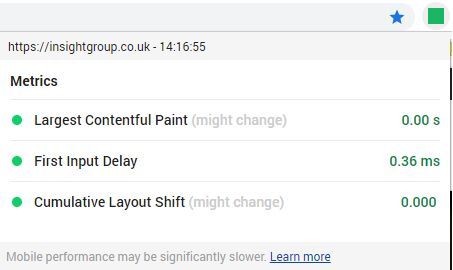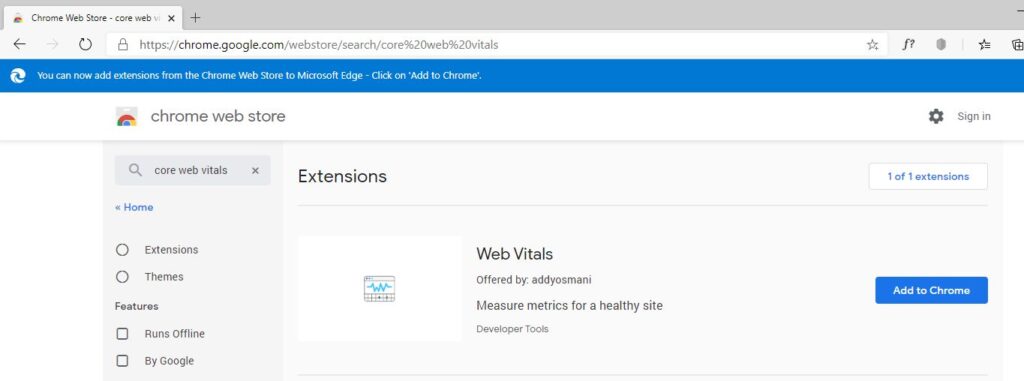Google search goalposts are moving again with the introduction of Google Core Web Vitals
Since 2010 Google has had a publicly stated focus on website performance. Initially it was Site Speed that websites had to meet to make sure they were in the running for good rankings. In 2018 it got pushed up a level with Page Speed Insights. Enter May 2020 and the introduction of:
Google Core Web Vitals

A top level measurement that will provide an instant ‘score’, make it easy to see which elements of your website are not meeting the required Google targets and enable you to compare your website against your competitor’s sites.
Why has Google introduced Core Web Vitals?
Google have run extensive research which shows that users prefer sites with a great page experience. Previously the focus has been on criteria including:
- how quickly pages load
- mobile-friendliness
- security
- avoiding pop-ups
- encryption (SSL)
These, and other factors were used for creating a site’s ranking results.
Google’s Core Web Vitals is a set of metrics related to speed, responsiveness and visual stability designed to help site owners measure user experience (UX) on the web which is defined as:
- Largest Contentful Paint (LCP) measures perceived load speed and marks the point in the page load timeline when the page’s main content has likely loaded.
- Essentially how quickly is your website page displayed to the visitor
- First Input Delay (FID) measures responsiveness and quantifies the experience users feel when trying to first interact with the page.
- When can your visitor start to scroll and click on the page
- Cumulative Layout Shift (CLS) measures visual stability and quantifies the amount of unexpected layout shift of visible page content.
- A focus on animation on the page. Looking to stop annoying pop-ups and also animation that shifts the screen up/down/left/right, making uncomfortable viewing for the visitor.
Each user experience has a speed target and measurement associated with it, much like Page Speed Insights:

How can you check your website?
Google has made it simple to see and test any site you visit, but your interest will be your own site initially, then your competitors and then sites you visit. Using Google’s Chrome browser (and browsers based on the Chromium framework like Microsoft’s Edge browser – see below) you can add an extension that has an icon display – RED for failed one or more of the three tests with a three letter acronym to match one of the tests and the score; and GREEN for passed. Click on the icon to see a drop down that shows the values:

In addition to the new Chrome extension Google is providing other ways to measure the Core Web Vitals:
- Google Search Console – a Core Web Vitals report is now available in Search Console to check pages across an entire site.
- Google Page Speed Insights – now uses Lighthouse 6.0 flags Core Web Vitals on the report with blue ribbon icon
- Chrome UX Report – public database of user experience which has Core Web Vitals
- Lighthouse 6 – recently updated to include Core Web Vitals reporting with Largest Contentful Paint, Cumulative Layout Shift and Total Blocking Time which maps to the First Input Delay measurement.
Chrome Dev Tools in the Chrome browser also provide key metrics in relation to the Core Web Tools.
Is Core Web Vitals now replacing all the other measurements?
Google is introducing this group of tests to work alongside other tests already in place:
The combined tests create a Search Signal result, these are:
- Largest Contentful Paint (LCP)
- First Input Delay (FID)
- Cumulative Layout Shift (CLS)
- Mobile Friendly – which is the default test for Page Speed Insights
- Safe Browsing, introduced in 2015 with Google Analytics to check and notify of any malware on the site
- HTTPS (SSL) – the security certificate for encryption of data between the website and visitor’s browser
- No Intrusive Interstitials – essentially pop-up ads that bloc the user’s page view
When do I need to sort out my website?
Google has said in its announcement that these changes will not happen before next year, and that they will provide at least six months notice before they’re rolled out. The tools are being provided to allow web owners and developers the time to ensure that the new criteria are met by next year.
We think what they are saying is ‘you’ve been warned, we’ve given you plenty of time, so don’t hang around’. Which is much better than announcing that ‘a Google Search Algorithm change took place yesterday’ which is the normal approach.
If you want to go further or need help to implement any of the above then we are here to support you and you can contact us directly on 01344 578 104 or via our contact form.
Installing Chrome extensions to Microsoft Edge
To add the Core Web Vitals extension, open Edge and then in Edge Settings select: Extensions > Turn on the Allow extensions from other stores toggle switch
Then visit the Google Chrome Extension Store and search for Core Web Vitals: https://chrome.google.com/webstore/search/core%20web%20vitals. The store display in Edge shows a banner telling you that ‘You can now add extensions from the Chrome Web Store to Microsoft Edge – Click on ‘Add to Chrome’. If you are familiar with adding extensions to Chrome then it works in just the same way.

Image credits: https://pixabay.com/users/j_hennemann-1681000/




Comments (0)